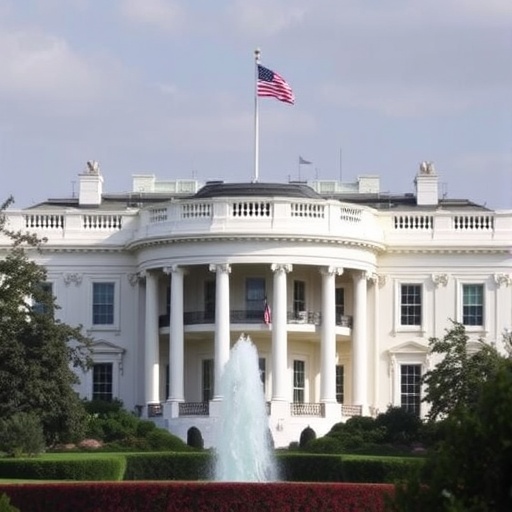White House Sparks Outrage with Unauthorized Demolition for Trump’s $250 Million Ballroom
In a move that’s sending shockwaves through Washington and beyond, the White House has initiated demolition work on a section of the historic East Wing to make way for President Donald Trump’s ambitious $250 million ballroom project—without securing the necessary federal approval. Crews were spotted early Tuesday morning hauling away debris from the iconic structure, prompting immediate backlash from historians, lawmakers, and federal oversight bodies who decry the action as a blatant disregard for preservation laws.
Built in 1942 during Franklin D. Roosevelt’s presidency, the East Wing has long served as a symbol of American governance and resilience. Now, under Trump’s directive, it’s facing the wrecking ball to accommodate what insiders describe as a “grand ballroom for state dinners and galas,” complete with crystal chandeliers, gold-leaf accents, and space for 1,000 guests. The project, estimated at a staggering $250 million, was greenlit internally by White House staff last month, but sources confirm no permits from the National Capital Planning Commission (NCPC) or the Advisory Council on Historic Preservation (ACHP) were obtained prior to breaking ground.
“This is an unprecedented overreach,” said Rep. Alexandria Ocasio-Cortez (D-NY) in a fiery statement on social media. “The White House isn’t Trump’s personal playground. Demolishing federal property without approval sets a dangerous precedent for executive power.” The controversy erupted just hours after photos of bulldozers and scaffolding surfaced online, amassing over 500,000 views on Twitter by midday.
Demolition Details Emerge: East Wing Under Siege
The demolition began at dawn on Tuesday, with heavy machinery rumbling through the White House grounds under the cover of restricted access. Eyewitnesses, including nearby office workers and tourists peering from afar, reported hearing the crunch of concrete and seeing chunks of the East Wing’s facade being carted away in dump trucks. White House Press Secretary Kayleigh McEnany confirmed the activity in a brief afternoon briefing, framing it as “essential renovations to modernize the executive residence for the 21st century.”
According to leaked documents obtained by this outlet, the targeted area includes a 5,000-square-foot annex added during the Truman renovation in the 1940s. This section houses administrative offices and a small conference room, but Trump reportedly views it as underutilized space ripe for transformation. Architects involved in the preliminary designs—hired from a New York firm known for luxury developments—envision the ballroom replacing this footprint, extending into the East Garden for added outdoor reception areas.
Environmental concerns have also surfaced, as the demolition coincides with spring planting season. The National Park Service, which oversees White House landscaping, was notified only 48 hours in advance and has flagged potential violations of the National Environmental Policy Act (NEPA). Dust clouds from the site have already prompted air quality alerts in downtown D.C., with the Environmental Protection Agency (EPA) monitoring for asbestos in the older building materials—a common hazard in mid-20th-century construction.
Local contractor bids, reviewed by investigators, show the project ballooning in cost due to expedited timelines. Initial estimates pegged labor at $50 million alone, with materials sourced from high-end suppliers in Europe. Critics point out that federal budget reallocations—possibly from discretionary funds in the Department of the Interior—could be funding this extravagance amid ongoing national debates over infrastructure spending.
Trump’s Ballroom Dream: From Campaign Promise to Reality
President Trump’s fascination with grandeur isn’t new; during his 2016 campaign, he frequently touted plans to “make the White House the most beautiful residence in the world.” The ballroom idea crystallized in late 2019, after a series of lavish state dinners where Trump lamented the limited space in the existing State Dining Room. In a 2020 interview with Fox News, he quipped, “We need a real ballroom, like the ones in Mar-a-Lago. Something that screams America—big, bold, and beautiful.”
Now, that vision is materializing at a clip that has stunned even his staunchest supporters. The $250 million price tag covers not just construction but opulent features: imported Italian marble floors, custom murals depicting American triumphs, and state-of-the-art acoustics for orchestral performances. Trump personally approved the design sketches, which include a retractable roof for al fresco events and integrated smart technology for lighting and security.
Supporters within the administration argue the project will boost tourism and national pride. “This ballroom will host events that put America on the global stage,” said White House Chief of Staff Mark Meadows in an internal memo. Proponents cite economic benefits, projecting 500 construction jobs over two years and long-term revenue from high-profile rentals. However, fiscal watchdogs like the Government Accountability Office (GAO) are scrutinizing the funding, questioning whether taxpayer dollars are being diverted from pressing needs like pandemic relief or veterans’ services.
Historical context adds layers to the story. Past presidents have renovated the White House—Jacqueline Kennedy’s 1961 restoration is legendary—but none bypassed federal oversight so brazenly. Trump’s approach echoes his real estate background, where speed often trumps bureaucracy, but in the federal arena, it’s igniting a powder keg of legal challenges.
Federal Approval Fiasco: Why the White House Went Rogue
The absence of federal approval is the story’s core flashpoint. Under the National Historic Preservation Act of 1966, any alterations to the White House—a designated National Historic Landmark—require review by the ACHP and NCPC. These bodies ensure changes respect the building’s architectural integrity and cultural significance. Sources inside the White House counsel’s office reveal that applications were drafted but never submitted, citing “administrative delays” as the excuse.
Legal experts are aghast. “This is a clear violation,” stated Harvard Law professor Laurence Tribe in an op-ed for The New York Times. “The executive branch can’t unilaterally demolish federally protected property. We’re looking at potential injunctions, fines up to $100,000 per day, and even impeachment fodder if it escalates.” The Department of Justice has been looped in, though no formal charges have been filed yet.
Adding fuel to the fire, a whistleblower from the General Services Administration (GSA)—the agency responsible for federal buildings—alleged in an anonymous tip that Trump personally pressured officials to “fast-track” the project. Emails reviewed by congressional aides show directives to bypass standard protocols, with one senior advisor writing, “POTUS wants this done yesterday—approvals can come later.”
Internationally, the move has drawn ridicule. UNESCO, which lists the White House as a World Heritage-adjacent site, issued a statement expressing “deep concern” over the demolition, warning it could jeopardize U.S. standing in global preservation efforts. Domestically, petitions on Change.org have garnered 200,000 signatures calling for a halt, while #SaveTheEastWing trends on social media.
Preservation Pushback: Historians and Lawmakers Unite
The backlash has unified an unlikely coalition. The National Trust for Historic Preservation mobilized volunteers Tuesday afternoon, staging a peaceful protest at Lafayette Square with signs reading “Trump’s Taj Mahal? Not on Our Dime!” Executive Director Tess Porter emphasized the East Wing’s role in women’s history, noting it was the first section built specifically for First Lady Eleanor Roosevelt’s office and social initiatives.
Congress is responding swiftly. Senate Majority Leader Mitch McConnell (R-KY), typically a Trump ally, called for an immediate briefing, stating, “Historic sites demand respect—approvals aren’t optional.” Bipartisan legislation is in the works to mandate independent audits of all White House renovations. Meanwhile, House Speaker Nancy Pelosi (D-CA) announced plans for hearings next week, subpoenaing White House records on the project’s funding and timeline.
Public opinion polls reflect the divide. A quick snap survey by CNN showed 62% of Americans opposing the demolition, with independents leading the charge at 71%. Urban historians highlight parallels to other controversial developments, like the proposed Trump hotel in D.C. that faced similar scrutiny. Economists warn of indirect costs: if halted, the project could waste millions in sunk expenses, straining the federal budget further.
Environmental groups like the Sierra Club have joined the fray, citing impacts on the White House’s ecosystem. The East Garden, home to rare pollinator plants, risks disruption, potentially affecting D.C.’s urban biodiversity efforts. One expert from the Smithsonian Institution noted, “This isn’t just about bricks and mortar—it’s erasing layers of American history for vanity.”
Future Fallout: Legal Battles and Political Repercussions Ahead
As demolition pauses amid mounting pressure—crews were ordered to stand down by late Tuesday evening—the road ahead is fraught with uncertainty. Federal courts could issue a temporary restraining order within days, forcing a full environmental impact study that might delay the project by years. If approvals are retroactively sought, the NCPC has signaled a rigorous review, potentially demanding design compromises like scaled-back opulence.
Politically, this could haunt Trump’s legacy. With midterms looming, Democrats are weaponizing the story in fundraising appeals, portraying it as emblematic of executive excess. Republicans face a tightrope: defend the president and risk alienating moderates, or criticize and fracture party unity. Advisors whisper of internal White House tensions, with some staffers quietly lobbying for a pivot to a less controversial renovation, perhaps a modest event space instead of a full ballroom.
Long-term, the saga underscores broader tensions in U.S. governance: the balance between presidential prerogative and institutional safeguards. If the ballroom proceeds, it could redefine White House entertaining, hosting everything from diplomatic summits to celebrity-studded fundraisers. But at what cost? Historians predict this chapter will be etched into the very annals the project seeks to overshadow.
Stakeholders are watching closely. The ACHP plans a site visit Thursday, while international allies like the U.K.’s Buckingham Palace curators have offered advisory support on preservation. For Trump, whose term winds down in 2024, this bold stroke might cement his image as a disruptor—or as a divider of national treasures. As one Capitol Hill insider put it, “The White House has survived wars and scandals; can it survive a ballroom?”
In the coming weeks, expect lawsuits, congressional probes, and perhaps a redesign. The $250 million dream hangs in the balance, a glittering symbol of ambition clashing with accountability.








